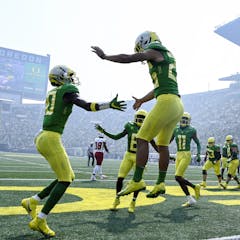
Articles on Wildfires
Displaying 181 - 200 of 378 articles

As the risk of fires rises in areas once considered too wet to burn, it creates hazards for mountain communities and for downstream water supplies.

A fire scientist explains the risk of flying embers that can travel over a mile from a wildfire and how people can protect their homes.

It might be time to reschedule football season. With rising temperatures, poorer air quality and a worsening hurricane season, climate change threatens the future of the American sport.

An atmospheric scientist and sailplane pilot describes why large areas of burned land can produce clouds and rainstorms.

Needs will continue in Haiti and New Orleans – and for Afghan refugees – long past the point when most donors will have found new priorities.

With a massive territory to manage, all actions taken - to prevent, to detect and to fire fight - aren’t enough.

To stay healthy, it’s important to understand how wildfire smoke can harm your body and how to protect yourself.

Smoke has long cast shadows across the skies in the northern hemisphere. Our aversion to smoke has influenced the way we’re willing to deal with the rising risk of wildfires.

Whether Canada is able to address the most pressing challenges of the next several generations requires the full participation and support of rural people and places.

Not all forests respond to hotter and drier conditions in the same way.

The ecological cost of the deadly fires in southern France will be enormous. Scientists and residents will have to find a way to rebuild together.

Large and out-of-control wildfires can seriously damage ecosystems, but Indigenous fire practices can keep ecosystems healthy and resilient, and even increase biodiversity.

Hundreds of computer simulations point to a few best strategies for keeping homes safe from fire in a warming climate.

More than 40 fire scientists and forest ecologists in the US and Canada teamed up to investigate why wildfires are getting more extreme. Climate change is part of the problem, but there’s more.

As wildfires continue to edge closer to towns and agricultural areas, grape producers and wine-makers in the Okanagan must once again deal with this increasingly frequent threat of smoke taint.

Scientists tend to study heatwaves and floods as discrete events – but this overlooks the crucial connections between them.

Efforts to predict wildfire risk and to prioritize mitigation efforts aren’t enough. We must prepare for fire disasters wherever possible and decide what we’ll do when they happen.

New research found that smoke from the Camp Fire in Paradise, California, carried high concentrations of lead. An environmental toxicologist explains what else you’re breathing and how to stay safe.

Every year, the number of wildfires caused by humans spikes on Independence Day. There are safer ways to celebrate amid the heat and drought.

Without enough water, trees can develop embolisms, similar to blockages in human blood vessels, and they’re more likely to die from drought or fires.
